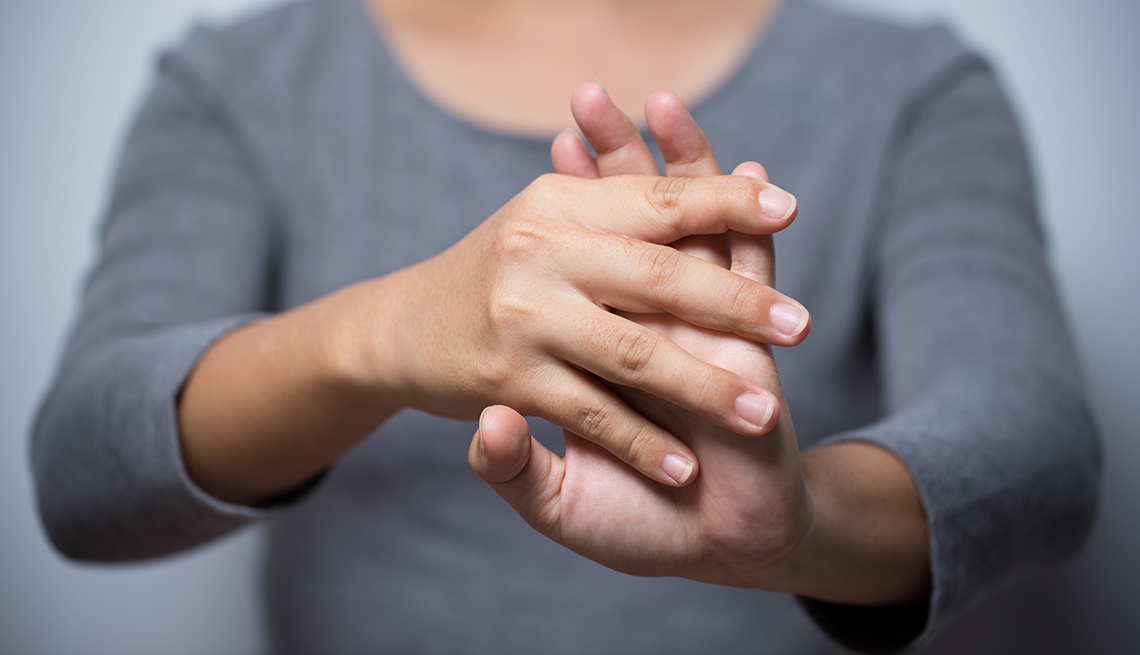
- Select a language for the TTS:
- UK English Female
- UK English Male
- US English Female
- US English Male
- Australian Female
- Australian Male
- Language selected: (auto detect) - EN
Play all audios:
Karen Jacobs noticed a stiffness settling into her hands. “It can be really painful throughout the day,” she says. When it didn’t resolve, the 70-year-old arranged a telehealth visit with
her doctor. His diagnosis: She was experiencing the beginning of osteoarthritis (OA), the most common type of arthritis. OA is a condition caused by the natural wearing away of the cartilage
that covers the bone, says Michelle G. Carlson, M.D., hand and upper extremity surgeon at the Hospital for Special Surgery in New York City. In healthy joints, the cartilage coverings at
the ends of the bones match up and glide smoothly against one another. But as arthritis wears the cartilage away, the movement becomes less smooth, often leading to stiffness, loss of motion
and pain, especially in the tip joint of the finger. It’s estimated that we have a 40 percent risk of developing symptomatic osteoarthritis during our lifetime, according to research in
_Arthritis & Rheumatology_. But while you can’t build back cartilage, you can preserve motion by keeping the soft tissue in the joint as supple as possible. Jacobs, an occupational
therapist, knew just what to do: start incorporating hand exercises into her day to maintain hand function. Research is mixed, but a 2018 study on 151 people with hand osteoarthritis found
that those who performed exercises at home for two months improved grip strength and had less pain and fatigue when compared with a control group. A caveat: Some exercises, like squeezing a
stress ball, can irritate joints by causing rough cartilage to rub together, Carlson says. Instead, Carlson and Jacobs recommend the following moves. When doing them, let pain be your guide:
If it hurts, stop. It’s also a good idea to get checked out by your doctor first to rule out other conditions, such as carpal tunnel syndrome, which is treated differently. Warm up in the
morning simply by going about your regular routine: Make breakfast, get dressed, feed the dog. Then, with your doctor’s OK, aim to go through these exercises every day. Plan to do five reps
on each hand. You can build these into routine activities, such as when you’re talking on the phone or watching TV. T.M. DETWILER EXERCISE 1: SHOULDER STRETCH Do your shoulders feel tense?
The impact can extend elsewhere. “Stiffness in your shoulders can lead to all sorts of problems in your extremities,” Carlson says. STEP 1: Stretch your arms up. Next, bend your right elbow
to reach your right hand behind your head toward your shoulder blades. STEP 2: With your left hand, grab your right elbow and then pull it gently toward the center of your back. Switch arms
and repeat. T.M. DETWILER EXERCISE 2: ELBOW FLEXION AND EXTENSION This exercise can help treat conditions such as tennis or golfer’s elbow. STEP 1: Stretch one arm out in front of you, palm
down. STEP 2: Now turn your palm up and bend at the elbow so that your palm moves toward your shoulder. STEP 3: Hold for a beat, then straighten your arm back out and turn your palm back to
the starting position.

:max_bytes(150000):strip_icc():focal(999x358:1001x360)/frank-grillo-the-resurrection-of-charles-mansion-030223-1-4566ab26a4f244159c1ee6d9b8fc89ca.jpg)






